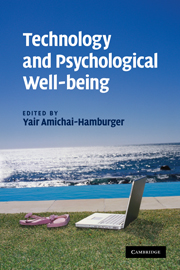Book contents
- Frontmatter
- Contents
- Figures
- Tables
- Contributors
- Acknowledgements
- Introduction
- 1 Communication technology and psychological well-being: Yin, Yang, and the golden mean of media effects
- 2 Internet and well-being
- 3 Information, innovation, and society
- 4 Work-related technological change and psychological well-being
- 5 From ergonomics to hedonomics: trends in human factors and technology
- 6 “Good teleworking”: under what conditions does teleworking enhance employees' well-being?
- 7 Commuting and well-being
- 8 Technology and medicine
- 9 Mothers of invention? The myth-breaking history and planetary promise of women's key roles in subsistence technology
- 10 Technology and well-being: designing the future
- Index
- References
7 - Commuting and well-being
Published online by Cambridge University Press: 22 December 2009
- Frontmatter
- Contents
- Figures
- Tables
- Contributors
- Acknowledgements
- Introduction
- 1 Communication technology and psychological well-being: Yin, Yang, and the golden mean of media effects
- 2 Internet and well-being
- 3 Information, innovation, and society
- 4 Work-related technological change and psychological well-being
- 5 From ergonomics to hedonomics: trends in human factors and technology
- 6 “Good teleworking”: under what conditions does teleworking enhance employees' well-being?
- 7 Commuting and well-being
- 8 Technology and medicine
- 9 Mothers of invention? The myth-breaking history and planetary promise of women's key roles in subsistence technology
- 10 Technology and well-being: designing the future
- Index
- References
Summary
The progress of human societies has always been associated with mobility and transportation. Since the earliest homo sapiens migrated from their cave dwellings over 100,000 years ago to establish civilizations in the valleys of the Tigris and Euphrates, human achievement and societal well-being has been dependent on our ability to transport ourselves and the goods that we produce. While the information age has radically modified both work products and the means of transportation, physical mobility on roadway systems remains fundamental to our commerce, recreation, and other life-sustaining activities. Indeed, mobility is very much associated with well-being, but the relationship is not uniform, as higher levels of travel may be reflective of constraints on opportunities, depletion of resources, and impairments to personal health and job performance.
Contemporary urban societies are fraught with stressful environmental conditions, among which traffic congestion features prominently. Remaining attached to the mode of private automobile travel and constrained by the availability of affordable housing, workers endure congested commutes and absorb the stressful consequences. As Dubos (1965, 1969) observed about human adaptation, we seem to develop tolerances to aversive environmental conditions and apparently function effectively in these less than healthy environs; however, as he also asserted, such adaptations in the present will be paid by misery in the future. Although potentially harmful urban conditions, such as exposure to noise, air pollution, and traffic congestion, become acceptable through habituation, the adaptive adjustments are achieved at the price of physical or psychological disturbances later in life.
- Type
- Chapter
- Information
- Technology and Psychological Well-being , pp. 174 - 205Publisher: Cambridge University PressPrint publication year: 2009
References
- 51
- Cited by



